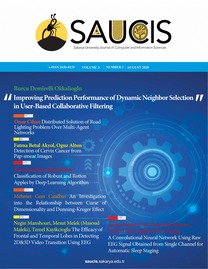Adding Virtual Objects to Realtime Face Images; A Case Study in Augmented Reality
Gerçek Zamanlı Yüz Görüntülerine Sanal Nesneler Eklenmesi; Artırılmış Gerçeklik Üzerine Bir Örnek Çalışma
___
[1] P. Chen, Z. Peng,., D. Li, and L.Yang, , "An improved augmented reality system based on AndAR", Journal of Visual Communication and Image Representation, 37, 63-69, 2016.[2] T. İçten and B. A. L Güngör, "Artırılmış gerçeklik üzerine son gelişmelerin ve uygulamaların incelenmesi", Gazi Üniversitesi Fen Bilimleri Dergisi Part C: Tasarım ve Teknoloji, 5(2), 111- 136, 2017.
[3] N. Wang, , X. Gao, D. Tao, H.Yang and X. Li, "Facial feature point detection: A comprehensive survey", Neurocomputing, 275, 50-65, 2018.
[4] P Viola and M. Jones, "Rapid object detection using a boosted cascade of simple features", In Proceedings Of The 2001 IEEE Computer Society Conference On Computer Vision And Pattern Recognition, CVPR 2001 (Vol. 1, pp. I-I). IEEE, December, 2001.
[5] E. Skodras and N. Fakotakis, "Precise localization of eye centers in low resolution color images", Image and Vision Computing, 36, 51-60, 2015.
[6] D. Chen, S. Ren, Y.Wei, X. Cao, and J. Sun, "Joint cascade face detection and alignment", In European Conference On Computer Vision, pp. 109-122, Springer, Cham, September, 2014.
[7] V. Schwind, "The golden ratio in 3D human face modeling", Stuttgart Media University, Stuttgart, 2011.
[8] A. M. Rahman, T. T Tran, S.A. Hossain and A. El Saddik, "Augmented rendering of makeup features in a smart interactive mirror system for decision support in cosmetic products selection", In 2010 IEEE/ACM 14th International Symposium on Distributed Simulation and Real Time Applications, pp. 203-206, IEEE, October, 2010.
[9] A. Javornik, Y. Rogers, A. M. Moutinho and R.Freeman, "Revealing the shopper experience of using a" magic mirror" augmented reality make-up application", In Conference on designing interactive systems, Vol. 2016, pp. 871-882, Association for Computing Machinery (ACM), 2016.
[10] Z Feng, F. Jiang and R.Shen, "Virtual Glasses Try-on Based on Large Pose Estimation", Procedia Computer Science, 131, 226-233, 2018.
[11] J. J. Lv, X. H. Shao, J. S. Huang, X. D. Zhou and X. Zhou, "Data augmentation for face recognition", Neurocomputing, 230, 184-196, 2017.
[12] M. Kim and K. Cheeyong, "Augmented reality fashion apparel simulation using a magic mirror", International Journal Of Smart Home, 9(2), 169-178, 2015.
[13] K. Diaz-Chito, A. Hernández-Sabaté and A. M. López, "A reduced feature set for driver head pose estimation", Applied Soft Computing, 45, 98-107, 2016.
[14] E. Murphy-Chutorian and M. M. Trivedi, "Head pose estimation and augmented reality tracking: An integrated system and evaluation for monitoring driver awareness", IEEE Transactions on intelligent transportation systems, 11(2), 300-311, 2010.
[15] H.Peng, "Application research on face detection technology based on OpenCV in mobile augmented reality", International Journal of Signal Processing, Image Processing and Pattern Recognition, 8(2), 249-256, 2015.
[16] Z. Mahmood, T. Ali, N. Muhammad, N. Bibi, I. Shahzad and S. Azmat, "EAR: Enhanced Augmented Reality System for Sports Entertainment Applications", KSII Transactions on Internet & Information Systems, 11(12), 2017.
[17] F.Pereira, C. Silva and M. Alves, "Virtual fitting room augmented reality techniques for ecommerce", In International Conference On Enterprise Information Systems, pp. 62-71, Springer, Berlin, Heidelberg, October, 2011.
[18] V Singh, V Shokeen and B Singh, "Face detection by haar cascade classifier with simple and complex backgrounds images using opencv implementation", International Journal of Advanced Technology in Engineering and Science, 1(12), 33-38. 2013.
[19] S. Soo, "Object detection using Haar-cascade Classifier", Institute of Computer Science, University of Tartu, 1-12, 2014.
[20] T.Kumar and K. Verma, "A Theory Based on Conversion of RGB image to Gray image", International Journal of Computer Applications, 7(2), 7-10, 2010.
[21] F.Patin, "An introduction to digital image processing", [Online]. Available: http://www. programmersheaven. com/articles/patin/ImageProc. pdf, 2003. [Accessed: 20-Jan-2020]
[22] G. Wolberg, " Digital image warping", Vol. 10662, pp. 90720-1264, Los Alamitos, CA: IEEE Computer Society Press, 1990.
[23] R. C. Gonzalez and R. E. Woods, Digital image processing, Pearson International Edition, Thid Edition, USA., 2008.
[24] R. Fang, K. D. Tang, N. Snavely and T. Chen, "Towards Computational Models of Kinship Verification", IEEE International Conference on Image Processing, Hong Kong, September 2010 (ICIP '10)
- ISSN: 2636-8129
- Yayın Aralığı: Yılda 3 Sayı
- Başlangıç: 2018
Finding the Relationship Between News and Social Media Users’ Emotions in the COVID-19 Process
Ahmet Anıl MÜNGEN, İrfan AYGÜN, Mehmet KAYA
Sentiment Analysis for Software Engineering Domain in Turkish
A Comparison of the State-of-the-Art Deep Learning Platforms: An Experimental Study
Energy Saving and Life Cycle Analysis of a Daylight-Linked Control System
Ceyda AKSOY TIRMIKÇI, Cenk YAVUZ
On Term Weighting for Spam SMS Filtering
Automatic Olive Peacock Spot Disease Recognition System Development by Using Single Shot Detector
Analysis of the Covid-19 Impact on Electricity Consumption and Production
Identification of Plant Species by Deep Learning and Providing as A Mobile Application
